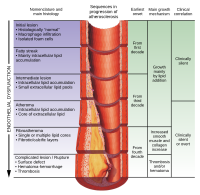
Photo from wikipedia
Systemic large arteries normally exert a powerful cushioning function, allowing for nearly steady flow and pressure in the microvasculature, despite the intermittent left ventricular ejection. Large artery stiffening (LASt) leads… Click to show full abstract
Systemic large arteries normally exert a powerful cushioning function, allowing for nearly steady flow and pressure in the microvasculature, despite the intermittent left ventricular ejection. Large artery stiffening (LASt) leads to loss of this cushioning function, with multiple deleterious consequences, including excessive transmission of pulsatility to the microvasculature of peripheral organs, excessive pulsatile afterload for the left ventricle, and a rapid diastolic pressure decay that can contribute to impaired coronary perfusion and flow reserve.1,2
Journal Title: Circulation Research
Year Published: 2020
Link to full text (if available)
Share on Social Media: Sign Up to like & get
recommendations!